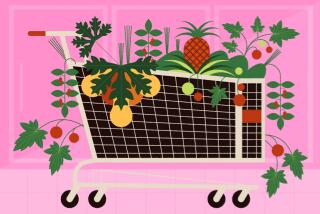Gardening : Macadamia Are Truly Hard Nuts to Crack
- Share via
QUESTION: When do I harvest macadamia nuts and how do I shell them? The shells are so hard they are probably “bullet-proof.”
ANSWER: Macadamia nuts grow in clusters like grapes and fall to the ground when ripe. They should never be picked from the tree because they are not fully ripe until they fall of their own accord. The husks, which are similar to walnut husks, should be removed and the nuts should be dried in the sun for two weeks.
Next comes the really tough job, the cracking and shelling of the nuts. If you have ever tried to crack a macadamia nut, you have discovered that they are the toughest of all nuts to shell. Many a finger has been smashed in the process of cracking macadamia nuts. They are probably best cracked with a hand nut cracker, and it is a long and tedious process. Some specialty nurseries sell a special macadamia nut cracker that makes the task easier.
Technique to Dry the Leaves of Eucalyptus
Q: Can you tell me how to dry eucalyptus leaves so that they are like the ones we purchase in the store?
A: Try air drying them. Here’s how to do it. Cut stems and leaves during the driest time of the day; moisture will discolor the foliage. Separate into small bunches and use rubber bands to secure the bunches. Hang the bunches upside down in a dark, well-ventilated area that has good air circulation and low humidity. It will take two or three weeks for the foliage to become completely dry.
Overwatering May Cause 95% Fruit Drop
Q: Why does my 40-year old persimmon tree always drop about 95% of its fruit before they are ripe? The tree has always been fed and watered well.
A: While it is natural for a persimmon tree to drop some of its fruit, it is certainly not normal for it to drop 95%. You mention that it is fed and watered well. It is probably watered too well. A mature persimmon tree does not need as much water as most other fruit trees; too much water will encourage fruit drop. Unless your soil is light, try doing a very deep watering once a month.
Lemon Bottlebrush May Be the Answer
Q: I hope this isn’t “mission impossible,” but can you suggest a fast-growing, good-looking hedge plant that will screen out my neighbor’s driveway? It also must be drought-tolerant and require little care.
A: That’s a tough assignment. However, the plant that comes to mind first is the lemon bottlebrush (Callistemon Citrinus). It thrives in most soils with little care, grows rapidly, bears pretty red blooms throughout the year, and once established, requires minimal watering. About the only attention it requires is pruning now and then.
Seeks Planting Time, Type of Calendula
Q: When should I plant calendula? What is a good type?
A: In most of the Southland, plant seeds in late summer or early fall. Bedding plants may be planted throughout the fall. Once established, plants thrive with little care. The Pacific Beauty series of the Dwarf Gem series are good calendula choices.
UC Publication Gives Olive Curing Recipe
Q: There are many olive trees on my property, and each fall the trees are loaded with olives. I have searched in vain for a recipe for curing the olives so that they can be eaten. Can you help?
A: the UC Farm And Garden Publication catalogue lists a publication called “ABC’s of Home-Cured Green Ripe Olives.” The price is listed at $1.50 and can be ordered from ANR Publications, University of California, 6701 San Pablo Ave., Oakland, 94608; phone (510) 642-2431.
Ornamental Pear Requires Full Sun
Q: Will an ornamental pear tree do well in an area of my yard that receives only three or four hours of sun daily?
A: No. Most ornamental pear trees (Pyrus) require an area of the landscape that receives full sun. While the trees will probably survive with limited sunlight, they will never reach their full potential.
Basil Goes to Seed Too Quickly Each Year
Q: Each year I plant basil, and it goes to seed very quickly and the plants are scraggly. How can I prevent this?
A: You must continually pinch off the plant’s blossoms before they flower and form seeds. Also, harvesting the top stems on a frequent basis will encourage the plants to be bushy.





